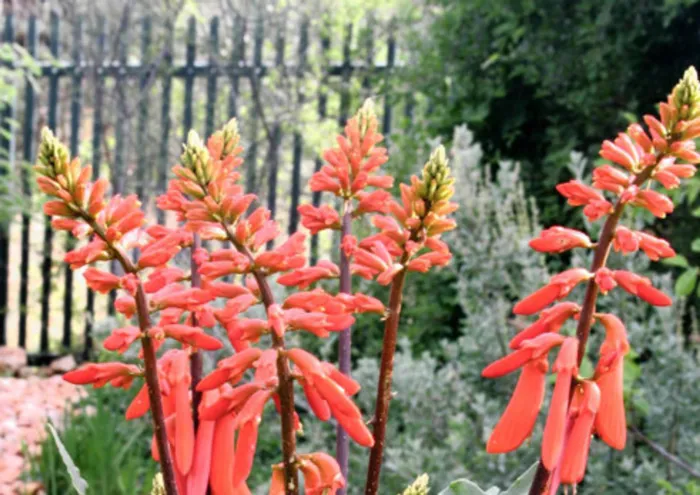Add colour with unusual attractions

SMALL AND COMPACT: The sun-loving, indigenous dwarf coral tree (Erythrina humeana) provides red flowers and is a colourful asset to any small garden. Picture: LOREN SHIRLEY-CARR SMALL AND COMPACT: The sun-loving, indigenous dwarf coral tree (Erythrina humeana) provides red flowers and is a colourful asset to any small garden. Picture: LOREN SHIRLEY-CARR
Cape Town - Do you have dwarf coral trees? That was the question posed to the owner of a garden centre in the southern suburbs by a shopper.
“What an interesting question,” I thought, pausing to listen in on the answer.
The nurseryman didn’t have dwarf coral trees on his retail floor, but swiftly pulled out a cellphone and within minutes announced he had sourced three sizes of dwarf coral trees. He could have a 1.2m dwarf coral tree delivered to her home within days. She ordered the plant and continued shopping.
The interchange was fascinating because it reminded me of how informed local gardeners have become about unusual and lesser-known plants.
Reaching only 1.5m, the indigenous dwarf coral tree (Erythrina humeana) is much smaller than its more famous coral tree cousin (Erythrina lysistemon), making it an ideal candidate for small water-wise gardens. Flower arrangers find the bright scarlet flowers on black stalks particularly attractive, and the nectar is relished by local birds.
If you are looking for unusually attractive plants this holiday weekend, also look out for the magnificent variegated bougainvilleas with white flowers (and bracts), as well as the glorious autumn-flowering Plectranthus “Mona Lavender” which are providing stunning blocks of colour in local garden centres.
Time to plant:
While the heat may not be entirely over, night temperatures are dropping and it is now an excellent time to plant up a new section to your garden. Trees and shrubs planted up in autumn will settle during the winter and have an early start to next summer.
How do you create a garden in a bare, windswept patch of grey seaside sand?
Pioneer planting is the key to success in any bare garden.
Start by planting a mixed shrubbery of fast-growing bushy species and slower-growing trees to provide a good long-term barrier. Plant shrubs close together as this creates a moist and agreeable micro-climate, where plants “support” one another.
Choose species that occur naturally in your area which are:
l Adapted to the wind and salt.
l Tolerate the drying effect of the wind.
l Have berries which attract birds, and these in turn will bring other plant species to your garden.
What should you plant?
The tickberry (Chrysanthemoides monilifera) is a fast-growing pioneer species. The glossy rhus (Searsia lucida syn. Rhus lucida) is fast-growing, tough and an ideal windbreak, while the euryops daisies (Euryops pectinatus X E. chrysanthemoides) is drought-resistant with large yellow daisy flowers.
Milkwoods (Sideroxylon inerme) are the classic Cape coastal trees, but are not as slow-growing as reputation would have it to be, if watered and fed. The waterberry (Syzygium cordatum) is a vigorous and large-leafed tree bearing showy, edible fruits in late summer.
A major component of coastal scrub forest, the dune olive (Olea exasperata) forms a large shrub which will attract birds to your garden. The camphor bush (Tarchonanthus camphoratus), Cape honeysuckle (Tecoma capensis), plumbago (Plumbago auriculata), Natal plum (Carissa macrocarpa) and sage bush (Buddleja salviifolia) are all excellent shrubs or small trees well suited to coastal conditions.
The wild sage (Salvia africana-lutea) is the strongly-scented sage which forms a major component of the natural coastal flora and will attract sunbirds to the garden, while the pink sage (Salvia dolomitica) needs light pruning to encourage dense growth. The confetti bush (Coleonema album) and wild rosemary (Eriocephalus africanus) are highly aromatic plants, producing attractive white flowers. The latter bears persistent fluffy seed heads typical of the genus.
Here are some guidelines on how to plant a pioneer tree or shrub for screening in your area:
l Dig a hole approximately 60cm x 60cm.
l Mix a handful of superphosphate and a handful of general organic fertiliser and a bucket full of compost. Place the mixture into the bottom of the hole and add a little soil. Mix thoroughly.
l Soak the roots of your tree in a bucket of water by submerging the entire bag.
l Plant your tree in the hole and fill in the sides with soil. Press the soil down around the tree with your foot to make sure it is securely in place.
l Water the tree thoroughly. - Weekend Argus